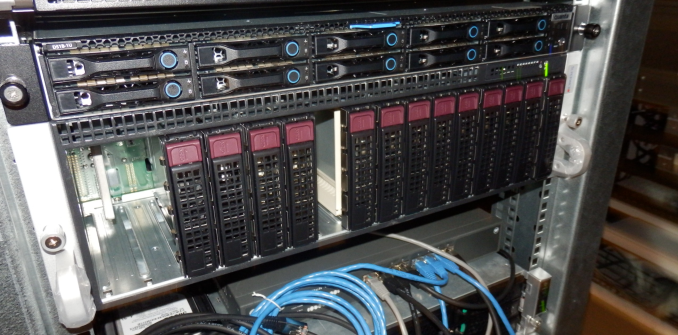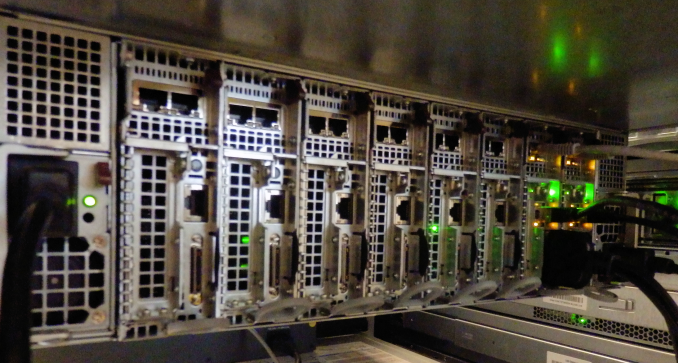X-Gene 1, Atom C2000 and Xeon E3: Exploring the Scale-Out Server World
by Johan De Gelas on March 9, 2015 2:00 PM ESTSupermicro's MicroCloud SYS-5038ML-H8TRF
Supermicro's 3U MicroCloud chassis is not a competitor for "advanced" micro servers such as AMD's SeaMicro SM15000 or HP's Moonshot. Advanced micro servers save power and keep management costs low due to an integrated fabric that routes networking and storage traffic very fast inside the box and only needs to be attached to the core switch via a few cables outside. You could say that the rack switch has been upgraded and integrated.
The Supermicro MicroCloud is a lot simpler. Only the power and cooling is shared among the nodes; there is no sophisticated integrated network or storage backplane. The MicroCloud still needs a separate switch and storage is pretty straightforward: each node has access to two disks.
Basically the MicroCloud is just a bunch of server nodes that share two redundant power supplies and cooling (4x 8 cm fans). As a result, it is a dense and inexpensive way to bundle eight (up to 24 in some SKUs) low-end servers. It is clearly targeted at the HPC and hyperscale datacenter where people want a "blade-like" server chassis but do not want to pay for features they rarely/never would use (e.g. centralized remote management/KVM, integrated switching, and SAN technology).
We've heard from several resellers that this chassis has been very successful, not in the least for being simple and affordable. Each node has a dual gigabit Intel i350 gigabit controller and one Ethernet interface for remote management; a KVM connector is also available. If you need more networking speed, one PCIe x8 slot is available.












47 Comments
View All Comments
JohanAnandtech - Tuesday, March 10, 2015 - link
Thanks! It is been a long journey to get all the necessary tests done on different pieces of hardware and it is definitely not complete, but at least we were able to quantify a lot of paper specs. (25 W TDP of Xeon E3, 20W Atom, X-Gene performance etc.)enzotiger - Tuesday, March 10, 2015 - link
SeaMicro focused on density, capacity, and bandwidth.How did you come to that statement? Have you ever benchmark (or even play with) any SeaMicro server? What capacity or bandwidth are you referring to? Are you aware of their plan down the road? Did you read AMD's Q4 earning report?
BTW, AMD doesn't call their server as micro-server anymore. They use the term dense server.
Peculiar - Tuesday, March 10, 2015 - link
Johan, I would also like to congratulate you on a well written and thorough examination of subject matter that is not widely evaluated.That being said, I do have some questions concerning the performance/watt calculations. Mainly, I'm concerned as to why you are adding the idle power of the CPUs in order to obtain the "Power SoC" value. The Power Delta should take into account the difference between the load power and the idle power and therefore you should end up with the power consumed by the CPU in isolation. I can see why you would add in the chipset power since some of the devices are SoCs and do no require a chipset and some are not. However, I do not understand the methodology in adding the idle power back into the Delta value. It seems that you are adding the load power of the CPU to the idle power of the CPU and that is partially why you have the conclusion that they are exceeding their TDPs (not to mention the fact that the chipset should have its own TDP separate from the CPU).
Also, if one were to get nit picky on the power measurements, it is unclear if the load power measurement is peak, average, or both. I would assume that the power consumed by the CPUs may not be constant since you state that "the website load is a very bumpy curve with very short peaks of high CPU load and lots of lows." If possible, it may be more beneficial to measure the energy consumed over the duration of the test.
JohanAnandtech - Wednesday, March 11, 2015 - link
Thanks for the encouragement. About your concerns about the perf/watt calculations. Power delta = average power (high web load measured at 95% percentile = 1 s, an average of about 2 minutes) - idle power. Since idle power = total idle of node, it contains also the idle power of the SoC. So you must add it to get the power of the SoC. If you still have doubts, feel free to mail me.jdvorak - Friday, March 13, 2015 - link
The approach looks absolutely sound to me. The idle power will be drawn in any case, so it makes sense to add it in the calculation. Perhaps it would also be interesting to compare the power consumed by the differents systems at the same load levels, such as 100 req/s, 200 req/s, ... (clearly, some higher loads will not be achievable by all of them).Johan, thanks a lot for this excellent, very informative article! I can imagine how much work has gone into it.
nafhan - Wednesday, March 11, 2015 - link
If these had 10gbit - instead of gbit - NICs, these things could do some interesting stuff with virtual SANs. I'd feel hesitant shuttling storage data over my primary network connection without some additional speed, though.Looking at that moonshot machine, for instance: 45 x 480 SSD's is a decent sized little SAN in a box if you could share most of that storage amongst the whole moonshot cluster.
Anyway, with all the stuff happening in the virtual SAN space, I'm sure someone is working on that.
Casper42 - Wednesday, April 15, 2015 - link
Johan, do you have a full Moonshot 1500 chassis for your testing? Or are you using a PONK?